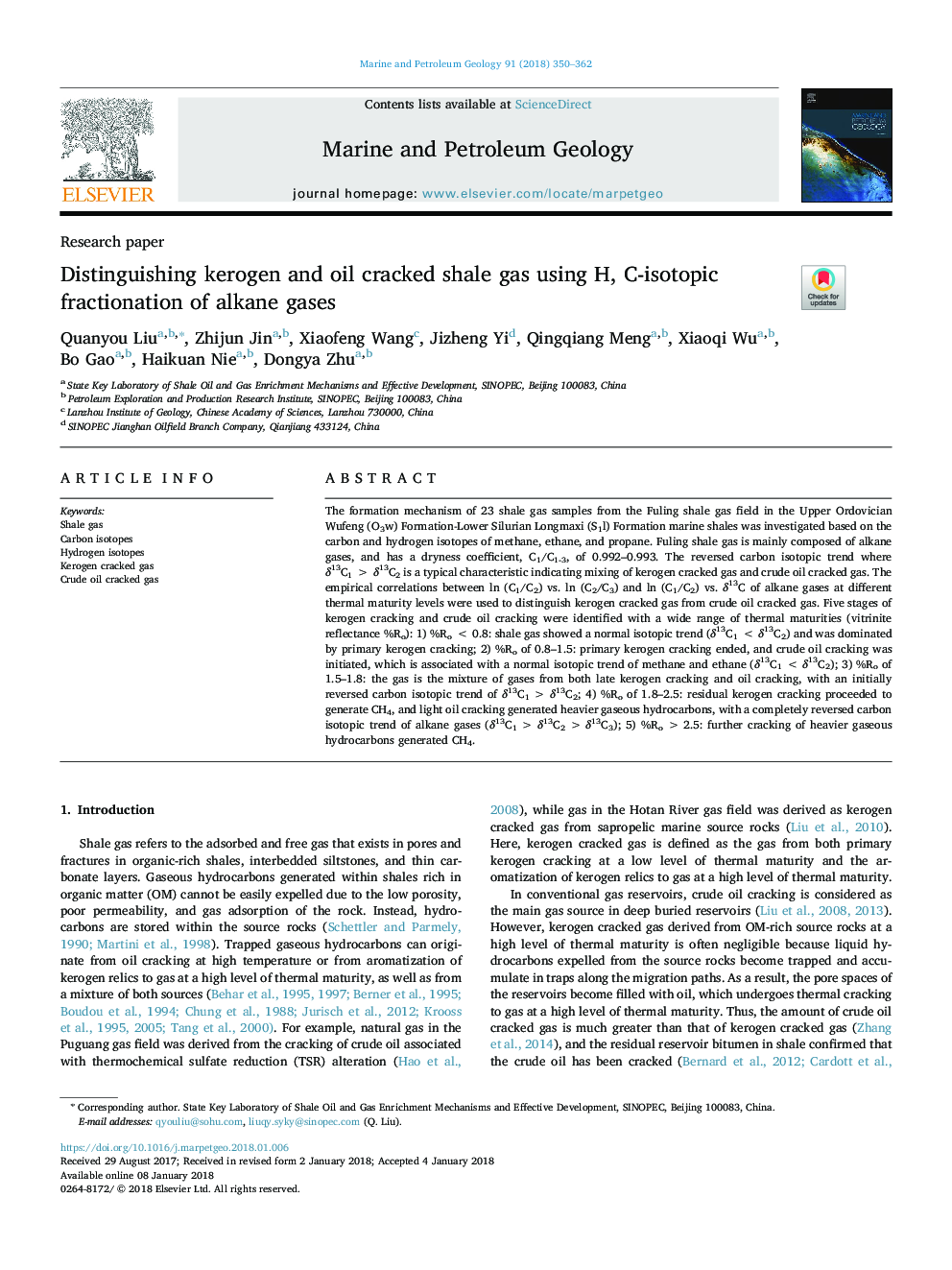| کد مقاله | کد نشریه | سال انتشار | مقاله انگلیسی | نسخه تمام متن |
|---|---|---|---|---|
| 8909190 | 1637134 | 2018 | 13 صفحه PDF | دانلود رایگان |
عنوان انگلیسی مقاله ISI
Distinguishing kerogen and oil cracked shale gas using H, C-isotopic fractionation of alkane gases
ترجمه فارسی عنوان
جداسازی کروژن و گاز شیل گاز ترک خورده با استفاده از تجزیه گاز کربن هیدروکسید کربن هیدروکسید کربن
دانلود مقاله + سفارش ترجمه
دانلود مقاله ISI انگلیسی
رایگان برای ایرانیان
کلمات کلیدی
گاز شیل، ایزوتوپهای کربن، ایزوتوپهای هیدروژن، کروژن گاز ترک خورده، نفت خام ترک خورده،
موضوعات مرتبط
مهندسی و علوم پایه
علوم زمین و سیارات
زمین شناسی اقتصادی
چکیده انگلیسی
The formation mechanism of 23 shale gas samples from the Fuling shale gas field in the Upper Ordovician Wufeng (O3w) Formation-Lower Silurian Longmaxi (S1l) Formation marine shales was investigated based on the carbon and hydrogen isotopes of methane, ethane, and propane. Fuling shale gas is mainly composed of alkane gases, and has a dryness coefficient, C1/C1-3, of 0.992-0.993. The reversed carbon isotopic trend where δ13C1â¯>â¯Î´13C2 is a typical characteristic indicating mixing of kerogen cracked gas and crude oil cracked gas. The empirical correlations between ln (C1/C2) vs. ln (C2/C3) and ln (C1/C2) vs. δ13C of alkane gases at different thermal maturity levels were used to distinguish kerogen cracked gas from crude oil cracked gas. Five stages of kerogen cracking and crude oil cracking were identified with a wide range of thermal maturities (vitrinite reflectance %Ro): 1) %Roâ¯<â¯0.8: shale gas showed a normal isotopic trend (δ13C1â¯<â¯Î´13C2) and was dominated by primary kerogen cracking; 2) %Ro of 0.8-1.5: primary kerogen cracking ended, and crude oil cracking was initiated, which is associated with a normal isotopic trend of methane and ethane (δ13C1â¯<â¯Î´13C2); 3) %Ro of 1.5-1.8: the gas is the mixture of gases from both late kerogen cracking and oil cracking, with an initially reversed carbon isotopic trend of δ13C1â¯>â¯Î´13C2; 4) %Ro of 1.8-2.5: residual kerogen cracking proceeded to generate CH4, and light oil cracking generated heavier gaseous hydrocarbons, with a completely reversed carbon isotopic trend of alkane gases (δ13C1â¯>â¯Î´13C2â¯>â¯Î´13C3); 5) %Roâ¯>â¯2.5: further cracking of heavier gaseous hydrocarbons generated CH4.
ناشر
Database: Elsevier - ScienceDirect (ساینس دایرکت)
Journal: Marine and Petroleum Geology - Volume 91, March 2018, Pages 350-362
Journal: Marine and Petroleum Geology - Volume 91, March 2018, Pages 350-362
نویسندگان
Quanyou Liu, Zhijun Jin, Xiaofeng Wang, Jizheng Yi, Qingqiang Meng, Xiaoqi Wu, Bo Gao, Haikuan Nie, Dongya Zhu,
